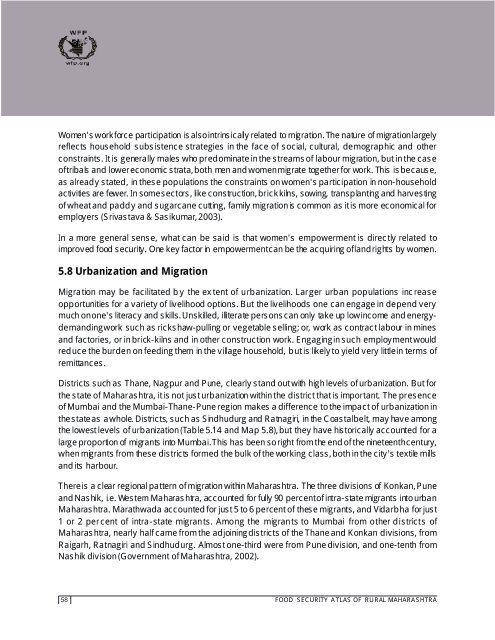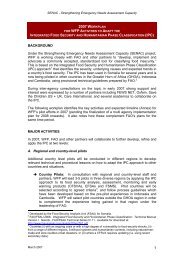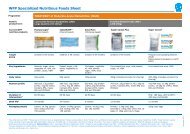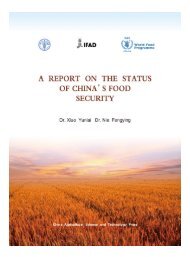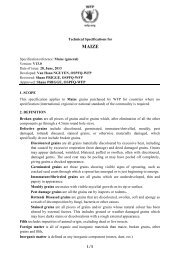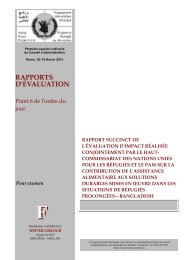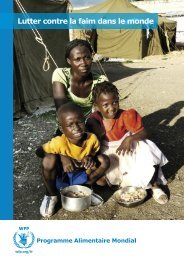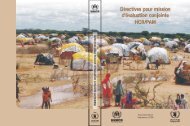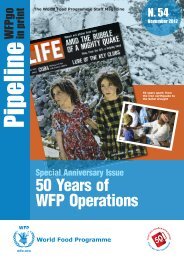Food Security Atlas Of RURAL MAHARASHTRA - WFP Remote ...
Food Security Atlas Of RURAL MAHARASHTRA - WFP Remote ...
Food Security Atlas Of RURAL MAHARASHTRA - WFP Remote ...
You also want an ePaper? Increase the reach of your titles
YUMPU automatically turns print PDFs into web optimized ePapers that Google loves.
Women's workforce participation is also intrinsicaly related to migration. The nature of migration largelyreflects household subsistence strategies in the face of social, cultural, demographic and otherconstraints. It is generally males who predominate in the streams of labour migration, but in the caseof tribals and lower economic strata, both men and women migrate together for work. This is because,as already stated, in these populations the constraints on women's participation in non-householdactivities are fewer. In some sectors, like construction, brick kilns, sowing, transplanting and harvestingof wheat and paddy and sugarcane cutting, family migration is common as it is more economical foremployers (Srivastava & Sasikumar, 2003).In a more general sense, what can be said is that women's empowerment is directly related toimproved food security. One key factor in empowerment can be the acquiring of land rights by women.5.8 Urbanization and MigrationMigration may be facilitated b y the ex tent of urbanization. Larger urban populations increaseopportunities for a variety of livelihood options. But the livelihoods one can engage in depend verymuch on one's literacy and skills. Unskilled, illiterate persons can only take up low income and energydemandingwork such as rickshaw-pulling or vegetable selling; or, work as contract labour in minesand factories, or in brick-kilns and in other construction work. Engaging in such employment wouldreduce the burden on feeding them in the village household, but is likely to yield very little in terms ofremittances.Districts such as Thane, Nagpur and Pune, clearly stand out with high levels of urbanization. But forthe state of Maharashtra, it is not just urbanization within the district that is important. The presenceof Mumbai and the Mumbai-Thane-Pune region makes a difference to the impact of urbanization inthe state as a whole. Districts, such as Sindhudurg and Ratnagiri, in the Coastal belt, may have amongthe lowest levels of urbanization (Table 5.14 and Map 5.8), but they have historically accounted for alarge proportion of migrants into Mumbai. This has been so right from the end of the nineteenth century,when migrants from these districts formed the bulk of the working class, both in the city's textile millsand its harbour.There is a clear regional pattern of migration within Maharashtra. The three divisions of Konkan, Puneand Nashik, i.e. Western Maharashtra, accounted for fully 90 percent of intra-state migrants into urbanMaharashtra. Marathwada accounted for just 5 to 6 percent of these migrants, and Vidarbha for just1 or 2 percent of intra-state migrants. Among the migrants to Mumbai from other districts ofMaharashtra, nearly half came from the adjoining districts of the Thane and Konkan divisions, fromRaigarh, Ratnagiri and Sindhudurg. Almost one-third were from Pune division, and one-tenth fromNashik division (Government of Maharashtra, 2002).58 FOOD SECURITY ATLAS OF <strong>RURAL</strong> <strong>MAHARASHTRA</strong>


